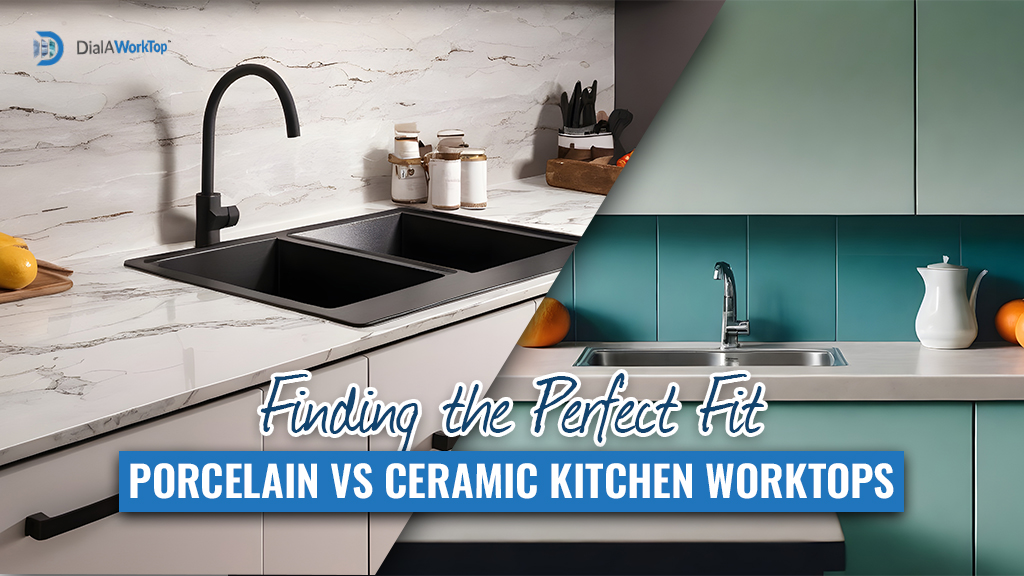From the colour of the cabinets to the style of the backsplash, every feature enhances the overall aesthetic and functionality of the kitchen space. One crucial decision that majorly contributes to the look of your kitchen is selecting the right material for kitchen worktops. Among the myriad options available, porcelain and ceramic kitchen worktops are popular with its own set of unique characteristics and benefits.
Let’s explore the subtle differences between porcelain and ceramic kitchen worktops, to make an informed choice according to your preferences and lifestyle.
Composition and Manufacturing:
Both porcelain kitchen worktops and ceramic kitchen worktops are clay-based materials, but their composition and manufacturing processes sets them apart.
Porcelain kitchen worktops, is manufactured from refined clay and subjected to high-pressure molding and firing at extreme temperatures, emerges with a dense and non-porous surface. This density renders porcelain highly resistant to stains, scratches, and heat, making it a durable choice for bustling kitchen environments.
On the other hand, ceramic worktops, composed of a mixture of clay, minerals, and water, undergo firing at lower temperatures, resulting in a sturdy yet slightly more porous surface compared to porcelain.
Appearance and Aesthetics:
In terms of aesthetics, both porcelain and ceramic kitchen worktops offer a rich tapestry of design possibilities. Porcelain kitchen worktops often mimic the luxurious look of natural stone, such as marble or granite, with intricate veining and textures that add depth to any kitchen space. Available in a diverse array of colours and patterns, porcelain worktops affords versatility to suit various design schemes.
Meanwhile, ceramic worktops boast their own charm, with options ranging from solid colours to intricate patterns and textured finishes. While ceramic may exhibit slight variations in colour and texture due to the firing process, these nuances contribute to its rustic allure.
Durability and Performance:
When it comes to durability, porcelain emerges as the frontrunner. Its dense composition offers superior resistance to impact, scratches, and moisture ingress, making it an ideal choice for high-traffic kitchens. Porcelain kitchen worktops also excel in UV resistance, ensuring long-term colour retention even in sun-drenched spaces.
Conversely, while ceramic kitchen worktops offer decent durability, they may be more susceptible to damage from heavy impacts and sharp objects. Additionally, ceramic’s porous nature requires proper sealing and maintenance to prevent staining and bacterial growth.
Maintenance and Care:
Both porcelain and ceramic kitchen worktops boast straightforward maintenance routines, though with slight differences. Porcelain’s non-porous surface repels liquids and stains, necessitating simple wipe-downs with mild soap and water to keep it looking pristine.
In contrast, ceramic worktops may require regular sealing to maintain their appearance and prevent moisture absorption. Routine cleaning with non-abrasive cleaners helps preserve the finish and integrity of ceramic surfaces, ensuring longevity and beauty.
Cost Considerations:
Cost often plays a pivotal role in decision-making, and the disparity between porcelain and ceramic kitchen worktops is noteworthy. Porcelain worktops may command a higher upfront investment due to their superior durability and aesthetic qualities. However, their long lifespan and minimal maintenance requirements translate to cost savings over time.
On the other hand, ceramic worktops offer a more budget-friendly option initially, but may incur higher maintenance costs and potentially require replacement sooner, offsetting the initial savings.
Porcelain kitchen worktops and ceramic kitchen worktops are both popular choices for kitchen worktops due to their durability, aesthetic appeal, and ease of maintenance. Here’s a breakdown of each:
Porcelain Kitchen Worktops:
- Made from dense, refined clay, offering a non-porous and durable surface.
- Highly resistant to scratches, stains, heat, and UV light.
- Available in a wide range of colours, patterns, and finishes, mimicking natural stone like marble or granite.
Popular brands include Neolith and Dekton.
Ceramic Kitchen Worktops:
- Crafted from a mixture of clay, minerals, and natural materials.
- Fired at high temperatures for strength and durability.
- Resistant to scratches, stains, heat, and moisture, though slightly more porous than porcelain.
- Offer diverse design options in colours, textures, and finishes.
Well-known brands include Caesarstone, Silestone, and Cambria.
Examples:
Neolith Calacatta Gold: Mimics the luxurious appearance of Calacatta marble.
Dekton Aura: Features a soft, neutral colour with subtle veining for a modern look.
Caesarstone Statuario Maximus: Resembles Statuario marble with white base and grey veining.
Silestone Lagoon: Offers a light grey base with delicate veining, suitable for various kitchen styles.
Both porcelain and ceramic kitchen worktops showcase diversity and beauty, enhancing the design and functionality of any kitchen or bathroom space.
Conclusion:
The choice between porcelain and ceramic kitchen worktops encompasses a myriad of factors, including budget, aesthetics, and practicality. While porcelain offers unparalleled durability and aesthetic versatility, ceramic presents a more economical option with its own unique charm. Whether you opt for the timeless elegance of porcelain or the rustic allure of ceramic, rest assured that your kitchen worktop will be a testament to quality craftsmanship and enduring beauty.
At DialAWorkTop Kitchen Worktop Installers and fitters, we’re dedicated to helping you find the perfect solution tailored to your needs. Our team of experts is here to guide you through the selection process, ensuring that your kitchen worktop not only meets but exceeds your expectations. Embrace the possibilities, to create the kitchen of your dreams—one worktop at a time.
